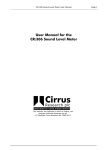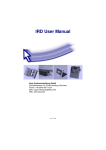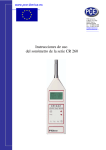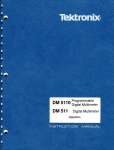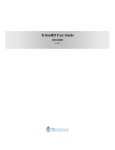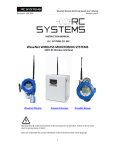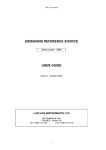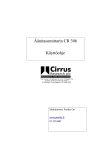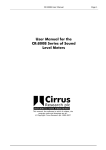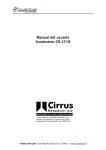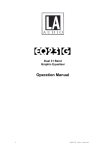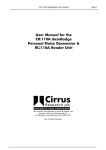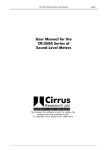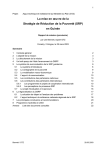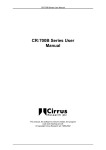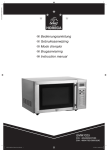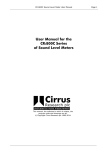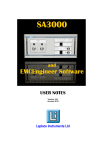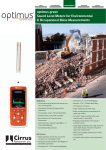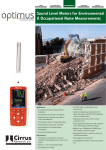Download User manual for the CR:261S Sound Level Meter
Transcript
CR:261S Vehicle Noise Sound Level Meter User Manual for the CR:261S Vehicle Noise Measurement Sound Level Meter This manual, the software to which it relates, the program code and drawings are all: © Copyright Cirrus Research plc 1989-2007 Page 1 Page 2 CR:261S Vehicle Noise Sound Level Meter The content of this manual, any illustrations, technical information and descriptions within this document were correct at the time of going to print. Cirrus Research plc reserves the right to make any changes necessary, without notice, in line with the policy of continuing product development and improvement. No part of this publication may be duplicated, reprinted, stored in a data processing system or transmitted by electronic, mechanical, photographic or other means, or recorded, translated, edited, abridged or expanded without the prior written consent of Cirrus Research plc. No liability is accepted for any inaccuracies or omissions in this manual, although due care has been taken to ensure that is it complete and accurate as possible. Accessories supplied by Cirrus Research plc have been designed for use with the instrumentation manufactured by Cirrus Research plc. No responsibility is accepted for damage caused by the use of any other parts or accessories. In order to take account of a policy of continual development, Cirrus Research plc reserves the right to change any of the information contained in this publication without prior notice. Produced by Cirrus Research plc, Acoustic House, Bridlington Road, Hunmanby, North Yorkshire, YO14 0PH, United Kingdom. © Copyright Cirrus Research plc 2007 Reference Number 07/01/CR:261S/01 Document Printing Date Friday, 02 February 2007 CR:261S Vehicle Noise Sound Level Meter Page 3 Preface ......................................................................................................................... 5 Manual Contents ......................................................................................................... 5 Messages and Symbols ................................................................................................ 6 Section 1 Introduction.................................................................................................. 7 Main Features............................................................................................................. 7 Measurement Functions ............................................................................................... 7 Single Measurement Mode............................................................................................ 7 Multiple Measurement Mode .................................................................................................... 7 Options & Accessories .................................................................................................. 7 Section 2 Getting Started ............................................................................................. 8 How to... ................................................................................................................... 8 Make a Single Mode Measurement............................................................................................ 8 Make Multiple Measurements ................................................................................................... 8 Quick Start................................................................................................................. 8 Section 3 Using the CR:261S Sound Level Meter......................................................... 11 Unpacking and checking the Sound Level Meter ............................................................. 11 Batteries .............................................................................................................................11 Windshield ...........................................................................................................................12 Keypad Functions ...................................................................................................... 13 Calibrating the Sound Level Meter ...........................................................................................13 Changing the Calibration Level................................................................................................14 Setting the measurement range .................................................................................. 14 Setting the measurement modes ................................................................................. 15 Single Measurement Mode.......................................................................................... 15 Multiple Measurement Mode with the Remote Control Cable ........................................................15 Switching off the instrument ....................................................................................... 16 Overload and Under-Range......................................................................................... 16 Section 4 Vehicle Noise Measurements....................................................................... 17 Overview ................................................................................................................. 17 Test Site..............................................................................................................................17 Background Noise and Wind Interference .................................................................................18 Number of Measurements ......................................................................................................18 Microphone Position................................................................................................... 18 Section 5 Maintenance & Care .................................................................................... 24 Section 6 Troubleshooting .......................................................................................... 25 Basics ..................................................................................................................... 25 Calibration ............................................................................................................... 25 Measurements & Settings ........................................................................................... 26 Section 7 Glossary ...................................................................................................... 27 Appendix 1 Rating Plate Information ......................................................................... 28 Appendix 2 Specifications........................................................................................... 31 Instrument Versions .................................................................................................. 31 Applicable Standards ................................................................................................. 31 Sound Level Meter ................................................................................................................31 Microphone .............................................................................................................. Microphone Preamplifier ............................................................................................. Extension cables ....................................................................................................... Time Weightings ....................................................................................................... Frequency Weightings................................................................................................ Amplitude Weighting ................................................................................................. Measurement Range .................................................................................................. Noise Floor (Typical).................................................................................................. Available Measurements............................................................................................. 31 31 31 31 31 31 31 31 31 Page 4 CR:261S Vehicle Noise Sound Level Meter Single Measurement Mode: ....................................................................................................31 Multiple Measurement Mode: ..................................................................................................32 Measurement Storage................................................................................................ Display .................................................................................................................... Weight .................................................................................................................... Dimensions .............................................................................................................. Batteries.................................................................................................................. Battery Life .............................................................................................................. Environmental .......................................................................................................... 32 32 32 32 32 32 32 Temperature ........................................................................................................................32 Humidity .............................................................................................................................32 Influence of Mechanical Vibration ................................................................................ External Connections ................................................................................................. Output Cables........................................................................................................... Electromagnetic Performance...................................................................................... 33 33 33 33 Appendix 3 Further Information ................................................................................. 34 Overload Levels ........................................................................................................ 34 CR:261S Directional Sensitivity...............................................................................................36 Horizontal............................................................................................................................37 Vertical ...............................................................................................................................39 Directional Sensitivity with UA:237 Windshield .............................................................. 42 Influence of the UA:237 Windshield ............................................................................. 46 Data Table ............................................................................................................... 48 Appendix 4 CE Certificate of Comformance................................................................. 50 Equipment Description ............................................................................................... 50 Guarantee................................................................................................................... 51 Cirrus Research Offices .............................................................................................. 51 CR:261S Vehicle Noise Sound Level Meter Page 5 Preface Thank you for purchasing the CR:261S Series Sound Level Meter. This instrument has been designed to be simple to use, and to provide the functions and features needed from a modern Sound Level Meter. This manual describes the procedure that should be followed to set up and operate the CR:261S Sound Level Meter, as well as comprehensive technical information, using optional accessories as well as troubleshooting. If you are a new user of Sound Level Meters or new to the CR:261S Sound Level Meter, first read Section 1 Introduction to familiarise yourself with the features, components and accessories supplied. Then read Section 2 Getting Started for step-by-step instructions on how to use the instrument. Specification Standard Instrument Time Weighting Fast Frequency Weighting dB(A) Run Time Manual Measurements LAF Sound Level, dB(A), Fast Time Weighting LAFmax Maximum Sound Level, dB(A), Fast Time Weighting Measurement Duration The CR:261S Sound Level Meter meets the requirements for IEC 61672-1:2003 standard for Class 1 Group X in all its modes. Please refer to page 31 for full technical details of the CR:261S Sound Level Meter. Manual Contents This manual is composed of the following sections. Section 1, Introduction, is an overview of the CR:261S Sound Level Meter features and capabilities. Section 2, Getting Started, provides a quick overview of how to begin using the instrument and how to carry out the basic measurements. Section 3, Using the CR:261S, describes the operation of the instrument. Section 5, Maintenance & Care, describes the procedure that should be followed to ensure the instrument operates as efficiently as possible, including changing batteries. Section 6, Troubleshooting, provides helpful information on how to perform some simple checks and suggests courses of action if the CR:261S Sound Level Meter does not seem to be working properly. The Glossary defines general Acoustic terminology and includes a list of acronyms and abbreviations used in this manual. The appendices contain technical information and specifications for the CR:261S Sound Level Meter. Page 6 CR:261S Vehicle Noise Sound Level Meter Messages and Symbols Messages are used in this manual to bring important information to your attention. The different message types are indicated as shown below. Pay attention! A caution informs you that improper use of the equipment or failure to follow instructions may cause data loss or may damage the equipment. i Please read. A note is a hint or advice that helps you make best use of the equipment and accessories. CR:261S Vehicle Noise Sound Level Meter Page 7 Section 1 Introduction Main Features Measurement Functions The Instrument has two main modes, the first being single measurement mode, the second being multiple measurement mode. Single Measurement Mode In Single Measurement Mode, the instrument displays LAF and LAFmax. In this mode the instrument is controlled by the keypad. Multiple Measurement Mode In Multiple Measurement Mode, the instrument displays the currnet LAFmax and the last two LAFmax’s. In this mode the instrument is controlled through a push button on a lead that connects to the bottom of the instrument Options & Accessories The CR:261S also available with a range of options and accessories that can enhance the performance and applications of the instrument. For full details, please contact Cirrus Research plc or your local representative. The most commonly used accessories are listed below. CR:511F CR:590 UA:237 CK:250 CP:65 CT:1 ZL:261S Acoustic Calibrator with PTB Type Approval Barometer for use with CR:511F Acoustic Calibrator Windshield Carrying Case Carrying Pouch for Sound Level Meter Tripod External Remote Control Cable (5m) Page 8 CR:261S Vehicle Noise Sound Level Meter Section 2 Getting Started How to... These example settings are designed to demonstrate the different configurations that are available from the CR:261S Sound Level Meter. Make a Single Mode Measurement Switch on Calibrate Press the Reset Key Make Multiple Measurements Switch on Calibrate Insert external switch cable Hold down the button to start measurement Release the button to end measurement Repeat Quick Start The information in this section is the same as that given in the CR:261 Quick Setup Guide. For more detailed information, please see section 3. 1. Switch On Cirrus Press the Power button to switch on the Sound Level Meter Re s e a r c h p l c CR:261S 1.00 The instrument will display the start up screen, and then will display the Single Mode screen 60 130 LAF dB t = 00:01:23 LAFMax dB CR:261S Vehicle Noise Sound Level Meter Page 9 2. Calibration Attach the Acoustic Calibrator to the Sound Level Meter and switch to the 94dB level setting. Press the Cal key to start the calibration procedure. Cal Attaching the Calibrator Gently push and twist the calibrator clockwise. When the calibration is complete, the display will change to show the calibration level. Remove the Acoustic Calibrator, switch off the calibrator and store. Calibrating Please wait 3. Mode Select With the cable not plugged in the instrument runs in single measurement mode With the cable plugged in the instrument goes into multiple measurement mode de dic 60 at ed 130 LAF d B Cir ru Re to s ea no is e rc h me as ur s pl c em en t 60 LAFm ax d B 130 LAFmax LAFm ax LAFm ax ___._ ___._ ___._ dB t = 00:01:23 t de dic at ed Cir Re to s ea no ise ru s rc h me as ure me pl c n t = 00:01:23 dB dB Page 10 CR:261S Vehicle Noise Sound Level Meter 4. Start Measurement 60 Single Measurement Mode Pressing the Reset key on the keypad clears the LAFmax hold functions and starts a new measurement. Multiple Measurement Mode When the cable is inserted and the button is held in it displays the LAFmax value, when the button is released and the depressed again, it moves the last LAFmax value to the next slot along and then starts a new measurement. 5. Switch off Press and hold the Power button to switch off the instrument. 130 LAF dB LAFMax dB t = 00:01:23 60 130 LAFMax ___._ dB t = 00:01:23 LAFMax 85.8 dB LAFMax 85.2 dB CR:261S Vehicle Noise Sound Level Meter Page 11 Section 3 Using the CR:261S Sound Level Meter Unpacking and checking the Sound Level Meter Carefully remove the instrument from its shipping container and inspect it for possible damage or missing items. If the meter appears to be damaged or something is missing, contact Cirrus Research plc or your local representative immediately. The CR:261S instrument is supplied with the following standard accessories: CR:261S User Manual Batteries 2 x AA If you have ordered the instrument as a complete measurement kit, you will have also received some further items such as an Acoustic Calibrator, Carrying Case and Windshield. Please refer to the manual supplied with the Acoustic Calibrator (where supplied) for details of fitting the battery and operation of this unit. Batteries The batteries of the CR:261S are located behind the cover on the bottom of the instrument. Slide the cover to the right hand side to remove and to access the battery holder. BATTERY COVER Ensure the instrument is switched off. Remove the battery holder from the instrument and insert the batteries. The CR:260 instruments uses two AA type batteries, also known as LR6. (1) Batteries (2) External Interface Socket (Not Used) (3) Remote Control Socket 3 Ensure that the batteries are inserted correctly. DO NOT reverse the polarity of the batteries as this may cause damage to the instrument. Page 12 CR:261S Vehicle Noise Sound Level Meter Windshield The CR:261S can be used with a UA:237 Foam Windshield which will reduce the noise levels generated by air turbulence over the microphone capsule. The windshield can also be used to protect the microphone capsule of the Sound Level Meter from dust and fluids which may affect the performance of the instrument. To use the UA:237 Windshield, push the hole in the windshield over the microphone of the Sound Level Meter. The UA:237 Windshield must be removed before the Sound Level Meter can be calibrated. CR:261S Vehicle Noise Sound Level Meter Page 13 Keypad Functions Measurement Mode Reset Select the measurement mode & view the current measurement mode settings Cal Press the CAL button to start the calibration procedure Press the Power Button to switch on the Sound Level Meter Cirrus Re s e a r c h p l c CR:261S 1.00 When the instrument is switched on, the Start-up screen will be displayed, and after a short time, the display will change to show the last measurement that was made. If there are no measurements in memory, the instrument will indicate that there are no measurements in the memory. Calibrating the Sound Level Meter Turn the acoustic calibrator level on the Acoustic Calibrator Gently push the calibrator onto the microphone capsule, slowly twisting clockwise. Cal Press the CAL button to start the calibration procedure During the calibration, the instrument will display the calibration status. Calibrating Please wait 60 130 Calibrated to 93.7 dBA If the calibration is successful, the instrument will display the calibration level. Press the Start button to begin a new measurement or to return to the main screen. Reset to measure If the calibration is not successful, the instrument will display an error message. These are shown below. CR:261S Vehicle Noise Sound Level Meter Page 14 60 130 The calibration level is below the set level. Check that the Calibrator is switched on and that it is connected correctly to the Sound Level Meter. SPL Too Low Not Calibrated Reset to measure 60 130 SPL Too high Not Calibrated The calibration level is above the set level. Check that the Calibrator is set to the correct level. Reset to measure 60 130 The calibration level is unstable. This maybe caused by high background noise levels. Move to a quieter location and retry the calibration. Unstable Not Calibrated Reset to measure To Remove the calibrator, gently pull the calibrator whilst twisting the calibrator clockwise. This will help to ensure that the microphone capsule does not become unscrewed from the instrument. For more information refer to Appendix 4 “Acoustic Calibrators”. Changing the Calibration Level The calibration level of the Sound Level Meter can be adjusted from the default level of 93.7dB. To change the calibration level, press and hold the Cal key for more than 2 seconds. 60 130 Press Cal to change level 93.7 Then Press Reset Use the Reset Key to cycle up through the levels. Press CAL to accept the new level and to return to the main operation of the Sound Level Meter. Setting the measurement range The CR:261S only has the one range which is 60 – 130 dB It is vital that the noise to be recorded, is within this range otherwise the instrument will be in Overload or in Under-range. CR:261S Vehicle Noise Sound Level Meter Page 15 Setting the measurement modes Single Measurement Mode In Single Measurement Mode, the instrument displays LAF and LAFmax. In this mode the instrument is controlled by the keypad. Pressing the Reset key will reset the run duration and the LAFmax hold value Multiple Measurement Mode with the Remote Control Cable In Multiple Measurement Mode, the instrument displays the currnet LAFmax and the last two LAFmax’s. In this mode the instrument is controlled through a push button on a lead that connects to the bottom of the instrument. When the ZL:261S Remote Control cable is plugged into the CR:261S Sound Level Meter, the instrument will automatically switch to the Multiple Measurement Mode. When first entering this mode there are no levels displayed untill the first measurement is taken. When a fourth measurement is taken the very first measurement is removed and so forth. When in this mode the cable does not effect any measurement perameters. de di 60 c at ed 130 LAF d B C ir rus Re to no sea is e r ch mea s ur em pl c en t 60 LAFm ax d B 130 LAFm ax LAFm ax LAFm ax ___._ ___._ ___._ dB t = 00:01:23 t de di c at ed C ir rus Re to sea noi se r ch mea s ur em pl c en t = 00:01:23 dB dB Page 16 CR:261S Vehicle Noise Sound Level Meter Switching off the instrument Press and hold the Power Button to switch off the Sound Level Meter. Overload and Under-Range If the noise level is over the instruments displayed range, the instrument will display the Overload symbol. If during a measurement the level is exceeded “OL” appears on the display, this stays present until the measurement is reset. If the noise level is below the instruments displayed range, the instrument will display the UnderRange symbol. When the level is no longer below the display range the “UR” symbol will disappear. 60 130 LAF d B t OL LA Fmax d B = 00:01:23 60 1 30 LAF dB LA Fmax dB UR t = 00:01:23 CR:261S Vehicle Noise Sound Level Meter Page 17 Section 4 Vehicle Noise Measurements If measurements are being made in accordance with ISO 5130 or any other Standard, Regulation or Guideline always refer to the appropriate documentation for test procedures and any other relevant information. The information contain in this section is provided as a general guide as to the use of the CR:261S Sound Level Meter for vehicle noise measurements. Reference to ISO 5130 in this manual refers to ISO 5130-1982. Text in italics below has been taken from the ISO 5130-1982 standard but is not a verbatim copy of the text in the standard. Always refer the any Standard, Regulations or Guidelines for details of test procedures the must be followed. Overview Test Site To reduce the influence of the surroundings on the noise measurements, a test site meeting the following requirements shall be used: Any open space may be considered to be a suitable test site if it consists of a flat area made of concrete, asphalt or hard material having a high acoustical reflectivity, excluding compressed or other earth surfaces. The edges of the test site shall be at least 3m from the extremities of the vehicle and there shall be no feature or object present on the test site likely to affect the reading of the Sound Level Meter; in particular the vehicle shall be at a distance of not less than 1m from a pavement edge when the exhaust noise is measured. Any obstacles outside the test site shall not be closer than 3m to the microphone during the test. With the exception of the observer and the driver, no person whose presence influences the meter readings shall remain in the test site during the test. The measurements shall not be made in adverse weather conditions. Gusts of wind shall not affect the measurements. It is recommended that tests should not be made in wind speeds at microphone height that exceed 5 m/s. The figures below show the recommended distances of the test areas for cars and motorcycles. CR:261S Vehicle Noise Sound Level Meter Page 18 Background Noise and Wind Interference The level of background noise (including any wind) at each measurement position shall be at least 10dB less than the levels measured during the tests. Number of Measurements At least three measurements shall be carried out at each measuring position. The measurements shall be considered to be valid if the range of three measurements made immediately one after the other is not greater than 2dB. The arithmetic mean given by these three measurements shall constitute the results. Microphone Position When the noise measurements are to be made close to the exhaust of the vehicle which is the common location of most measurements of this type, the positioning of the microphone is important. The microphone capsule of the instrument, not the body of the Sound Level Meter, must be positioned as follows: Vertical: In line with the exhaust but not less than 0,2m from the ground Horizontal: 0,5m from the outlet of the exhaust at an angle of 45o ± 10o The microphone must be placed on the outside edge of the vehicle. The CT:4 Tripod supplied with the CK:261S Sound Level Meter Measurement kit will position the microphone capsule at a height of 0,2m from the ground. CR:261S Vehicle Noise Sound Level Meter Page 19 The Positioning Template supplied with the CK:261S Vehicle Noise Measurement Kit will put the microphone at 0,5m and 45 o from the exhaust. The figures below show the positioning of the microphone in relation to the vehicle. Page 20 CR:261S Vehicle Noise Sound Level Meter CR:261S Vehicle Noise Sound Level Meter Page 21 Page 22 CR:261S Vehicle Noise Sound Level Meter For vehicles with two or more exhausts spaced not more than 0,3m apart and connected to a single silencer, only one measurement position shall be used. The microphone position shall be related to the exhaust outlet nearest to the outside edge of the vehicle. For vehicles with a vertical exhaust (for example commercial vehicles) the microphone shall be placed at a height of the exhaust outlet, orientated upwards and with the vertical axis of the exhaust. It shall be placed 0,5m from the side of the vehicle nearest to the outlet orifice. CR:261S Vehicle Noise Sound Level Meter Page 23 For vehicles provided with exhaust outlets spaced more than 0,3m apart, one measurement shall be made for each outlet as if it were the only one and the highest level noted. Page 24 CR:261S Vehicle Noise Sound Level Meter Section 5 Maintenance & Care The CR:261S is a precision measurement instrument and should be treated with care. Do not allow the instrument to be exposed to substances which may cause damage to the components of the unit. If the instrument is to be used in an environment where particles such as dust may come into contact with the instrument, always use a Windshield (UA:237) to protect the microphone capsule. The instrument is not waterproof and should not be used in situations where moisture will form or condense on the microphone capsule or the instrument body. If the instrument becomes dusty, wipe it down with a cloth that is lightly dampened with water or a mild detergent. Do not use aromatic hydrocarbons, chlorinated solvents, or methanol-based fluids when wiping down the meter. Do not clean the microphone capsule. Do not remove the microphone grill as this can cause severe damage to the membrane. Physical damage to the microphone capsule is not covered by the instrument warranty. To remove the microphone from the pre-amp make sure you grasp it by the bottom section of the microphone not by the microphone grill. To unscrew the microphone turn it anti-clockwise. If you experience any problems with the operation of the instrument, refer to page 25 for basic troubleshooting. If this does not solve the problem, contact Cirrus Research plc or your local representative for further assistance. CR:261S Vehicle Noise Sound Level Meter Page 25 Section 6 Troubleshooting This section contains information which may solve simple operational problems you may encounter. If you are unable to solve the problem or experience any problems with the assembly or operation of the instrument contact Cirrus Research plc or your local representative for further assistance Basics Symptom The instrument does not switch on Possible Cause The batteries are not fitted The batteries are flat or very low The batteries are not correctly fitted The instrument has become corrupted Possible Remedy Fit new batteries and switch on Fit new batteries and switch on Remove the batteries and check the polarity of the batteries Contact your local distributor or Cirrus Research plc Calibration Symptom The calibration fails: Too Low Possible Cause The Acoustic Calibrator is not switched on The Acoustic Calibrator is not fitted correctly The microphone capsule is loose or not fitted Calibration level set to a different level The Microphone may be damaged The calibration fails: Too High The calibration fails: Unstable The Acoustic Calibrator is set to a higher level than the expected level The background noise level is within 15dB of the calibration level The Microphone may be damaged Possible Remedy Switch on the Acoustic Calibrator and retry Check that the Acoustic Calibrator is fitted according to the instructions supplied. Check that the microphone capsule is tight and fitted correctly Set the calibration level to the value provided by the Acoustic Calibrator. Contact Cirrus Research plc or your local representative for assistance Set the Acoustic Calibrator to the correct level Move to a location where the background noise level is more than 15dB below the calibration level Contact Cirrus Research plc or your local representative for assistance Page 26 CR:261S Vehicle Noise Sound Level Meter Measurements & Settings Symptom Overload symbol is shown Under Range symbol is shown Possible Cause The noise level is too high for the current range The noise level is too low for the current range Possible Remedy CR:261S Vehicle Noise Sound Level Meter Page 27 Section 7 Glossary ‘A’ Weighting A standard weighting of the audible frequencies designed to reflect the response of the human ear to noise. Acoustic Calibrator An instrument that provides a reference noise source that is used to calibrate and check the performance of a Sound Level Meter. Broadband Noise Measurements using parameters which include all the audible noise, such as dB(A) and dB(C) CE Marking A label used to show that the Sound Level Meter conforms to the specification of a European Directive dB(A) Decibels A weighted Decibel (dB) The units of sound level and noise exposure measurement Fast Time Weighting A standard time weighting applied by the Sound Level Meter IEC 61672-1:2003 The International standard for Sound Level Meter and Integrating Averaging Sound Level Meters that replaces both IEC 60651 and IEC 60804 LAF Sound level with ‘A’ Frequency weighting and Fast Time weighting LAFmax The maximum Sound level with ‘A’ Frequency weighting and Fast Time weighting LCF Sound level with ‘C’ Frequency weighting and Fast Time weighting LCFmax The maximum Sound level with ‘C’ Frequency weighting and Fast Time weighting Overload The input to the Sound Level Meter is too high for the current measurement range. Change the range Sound Level Sound Pressure Level with a Frequency weighting, such as dB(A) Sound Level Meter An instrument for measuring various noise parameters SPL Sound Pressure Level, the basic measure of noise loudness, expressed in decibels Class 1 Laboratory & Field Grade for Sound Level Meters Classs 2 General Field Grade for Sound Level Meter Under Range The input to the Sound Level Meter is too low for the current measurement range. Change the range Page 28 CR:261S Vehicle Noise Sound Level Meter Appendix 1 Rating Plate Information The CR:261S meets the requirements of IEC61672-1:2002. These specifications require that this manual provides detailed information to verify that the specifications are met. While much of the data required is in the body of this manual, the points required to be detailed are listed below in the order in which they occur in the IEC specification. The CR:261S Sound Level Meter meets the requirements for IEC 61672-1:2003 standard for Class 1 Group X in all its modes. The MK:226 Type 1 Electret microphone is the only microphone used with the CR:261S. The reference direction of incidence is parallel to the sides of the case towards the microphone capsule. The range of measurement for SPL measurement with a standard assembly is:: 60 to 130 dBA : 60 to 130 dBC The self-noise is both with A and when C-evaluation under 54 dB (C-Weighting is provided for testing purposes). This applies with the ZL:261S Remote Control Cable attached. For signals with a crest factor of up to 10 the top span of the unit can be reduced by up to 17dB. This means that a signal with a crest factor of ten will produce an overload at 17dB below the expected top of the range selected. The reading of this signal will be within the tolerances of IEC60651 up to the point where the overload occurs. With ‘A' Frequency Weighting, the linearity range exceeds 70dB. The reference sound pressure is 1 Pa (94dB). The frequency weighting characteristic for measurements is A weighting. ‘F’ response is fitted with a 'Maximum Hold' on the max RMS value of each. This parameter can be read in all modes An acceleration of 0.1g over the frequency range 63 - 4kHz results in a reading of less than 50dB on any axis or weighting. 1 oersted produces a reading of less than 50dB on any weighting. The units operate from - 10 degree C to + 50 degree C with a maximum reading change of +0.5dB but is typically less than 0.3dB. We recommend that the operator should be at least 1m from the microphone during measurement. The specification is met at temperatures from -10 to +50 degrees C. The maximum deviation amounts to +0.5 dB (typical < 0.3 dB). The unit will meet its specification at any humidity from 0 to 95 % RH. CR:261S Vehicle Noise Sound Level Meter Page 29 Maximum storage temperature of +60 degree (+50 degree extended period) and 50% RH should be observed. Care should be taken when taking an instrument rapidly from sub zero temperatures to room temperature or above as condensation can take place inside the instrument and temporarily affect accuracy. No long-term damage should take place however. The UA:237 Windshield has a small effect upon the measurement. Between 1kHz and 10kHz this is less than 0.5dB. Please refer to page 46 for details.. The use of a pistonphone (PF:101C) is recommended to ensure long term compliance but for general short term compliance the CR:511F is used. They should be returned to the factory annually to be checked against a secondary or transfer standard. Any corrections specified in the calibrator or pistonphone manual should be applied for temperature or barometric pressure variation. The observer should be behind the case for optimum results. The operator should ever be at the side or in front of the unit. When using cables which are not supplied by Cirrus Research plc, the performance of the instrument cannot be guranteed. The reference frequency used for calibration is 1kHz. The reference range is 60dB to 130dB. The warm up period is less than 10 secs although it is recommended that the unit should be switched on for at least one minute before calibration to provide optimum accuracy. Never attempt calibration of an instrument that has not stabilised in temperature with its surroundings if you are seeking accurate results. The settling time before valid Leq readings of constant signals are within 0.5dB of their final reading is 10secs and within 0.1dB within 1minute. The battery life is greater than 12 hours with continuous use for average readings at 20dB below top of scale and at reference conditions. This value will vary dependant on the quality of the Alkaline batteries used and will diminish if levels near top of scale are constantly monitored or if the batteries are at a low temperature. Dummy microphone impedance is 18 pF in series with 50ohm. Primary indicator range is 55dB to 95dB on the centre reference range. An overload will always occur before non-linear distortion takes place and before the linearity range is exceeded. The microphone and associated electronics will be undamaged by sound levels in excess of 160dB The greatest peak to peak voltage applied electrically without damaging the SLM should not exceed 15V. The Sound Level Meter corresponds the requirements of IEC 61672-1:2002 regarding RF Immunity and EMC Emmissons. Page 30 CR:261S Vehicle Noise Sound Level Meter Calibration can be performed under the extremes of conditions within which the SLM meets the requirements of 61672. There is no AC output available on the CR:261S. The microphone preamplifier is not removable. A special RS232 cable and communication protocol can be provided , on request, for use by approved Test Houses requiring to access the continuous LAF level and LAFmax in either A-weighting or C-weighting for Pattern Approval purposes. The operating mode that produces the highest RF emissions is when the unit is running with the ZL:261S cable attached (coiled in a figure of eight configuration) The calibration procedure and the correction data apply within 65 kPa to 108 kPa for static pressure, 0°C to +50°C temperature, 25% to 90% r.H without dew points from 10°C to 39°C. The version of the firmware is displayed when the Sound Level Meter is switched on. NOTE! Do not open the Sound Level Meter. Damage can be caused by electrostatic discharge when opening the equipment. 60 t = 00:01:23 LAF dB 130 LAFmax dB CR: 2 6 1 S Reset Sc h a l l p e g e l m e s s e r Kal Cirrus Researchplc dedi cated tonois emeas uremen t CR:261S Vehicle Noise Sound Level Meter Page 31 Appendix 2 Specifications Instrument Versions CR:261S Type 1 Applicable Standards Sound Level Meter IEC 61672-1:2002 Class 1 Group X Microphone Type 1 Class+ Type 1 pre-polarized Free-field ½" Condenser Nominal Sensitivity of 50mV/Pa at 1000Hz Capacitance 18pF Microphone Preamplifier Type 1 MV:200C Integral Preamplifier Extension cables None Time Weightings ‘F‘ (Fast) to IEC 61672-1:2002 Class 1 Group X The response time for Fast being 0,125s Frequency Weightings ‘A' (A Weighting), ‘C’ (C Weighting) Amplitude Weighting Q=3 (True Energy Integration) Measurement Range 60dB(A) to 130dB(A) Class 1 60dB(C) to 130dB(C) Class 1 Noise Floor (Typical) 54dB(A) Class 1 54dB(C) Class 1 The noise floor of the instrument is 6dB below the bottom of the measurement range of the instrument. Available Measurements Single Measurement Mode: LAF Sound Level (Not Stored), dB(A), Fast Time Weighting CR:261S Vehicle Noise Sound Level Meter Page 32 LAFmax Maximum Sound Level, dB(A), Fast Time Weighting LCF Sound Level (Not Stored), dB(C), Fast Time Weighting LCFmax Maximum Sound Level, dB(C), Fast Time Weighting Measurement Duration Multiple Measurement Mode: LAFmax Maximum Sound Level, dB(A), Fast Time Weighting Measurement Duration Measurement Storage No measurement data is stored. Display Graphical LCD with Quasi-Analogue Display Selected measurement parameter with level Warnings for Overload, Under Range Battery Level Time & Frequency Weighting Elapsed measurement time Measurement Range Refresh rate of twice per second Weight 450 gms Dimensions 340mm x 75mm x 25mm Batteries 2 x 1.5v Alkaline LR6/AA Battery Life Typically >12 hours Battery voltage is continuously monitored and warning is given on display of impending low battery condition. When batteries approach end of life the unit will store any data required and switch off automatically. Environmental Temperature Operating Storage -10oC to +50oC -20oC to +60oC Humidity Up to 95% RH Non Condensing CR:261S Vehicle Noise Sound Level Meter Page 33 Influence of Mechanical Vibration For mechanical vibrations with an acceleration of 1m/s² perpendicular to the level of the microphone membrane for the frequencies 31.5 Hz, 63 Hz, 125 Hz, 250 Hz, 500 Hz, 630 Hz, 800 Hz and 1000 Hz, the lower limit of the linear working area for frequency weighting A is increased to 75dB. For mechanical vibrations with an acceleration of 1m/s² parallel to the level of the membrane, the lower limit of the working area for a frequency weighting A is increased to 64dB. External Connections External switch connected via 8-pin mini DIN Output Cables ZL:261S Electromagnetic Performance EN EN EN EN 55022:1998 61000-4-2:1995 61000-4-3:2002 61000-4-8:1994 CR:261S Vehicle Noise Sound Level Meter Page 34 Appendix 3 Further Information The unit’s function is not affected by electrostatic discharges at +/- 4kV contact discharges and +/- 8kV air temperature increase. The highest sensitivity to voltage change occurs if the antenna / aerial is pointing towards the LCD screen via polaristion of the antenna / aerial in the longitudinal axis of the sound level meter with the external cable connected and coiled in a figure eight configuration. The meter’s self-noise is neither affected by external factors nor by the meter’s configuration. This is the case for both acoustic and electrical self-noise. The mini DIN socket is designed only for use by the manufacturer for test purposes. Dummy microphone impedance of the microphone is 18pF in series with an input impedance of 50 ohm. Such impedance can be supplied by the manufacturer as KP:66. The external cable for remote control use is a 5m long encased co-axial cable with a one-touch start trigger switch. Overload Levels The start point for all tests of the linear operating range is 94dB, except the A-weighted linearity at frequencies lower than 50Hz, for which the level is 74dB. Limits of the linear working areas [dB] 31.5 Hz 1 kHz 12.5 kHz LAF from 60 to 92 from 60 to 130 from 60 to 126 LCF from 60 to 128 from 60 to 130 from 60 to 124 A-Weighting Overload levels (lowest level at which the overload signal appears): 31.5 93dB 1k 131dB 4k 131dB 8k 131dB 12k5 127dB C-Weighting Overload levels (lowest level at which the overload signal appears): 31.5 129dB 1k 131dB 4k 131dB 8k 128dB CR:261S Vehicle Noise Sound Level Meter 12k5 125dB Note: C-Weighting is used for test purposes only. Frequency weightings and Tolerances for ‘A’ and ‘C Weighting Nominal Frequency Frequency Weighting Tolerance Hz 10 12.5 16 20 25 A dB -70.4 -63.4 -56.7 -50.5 -44.7 C dB -14.3 -11.2 -8.5 -6.2 -4.4 (Class 1) dB +3;-∞ +3.0;- ∞ +2.5;-4.5 +/-2.5 +2.5;-2.0 31.5 40 50 63 80 100 125 160 200 250 315 400 500 630 800 1000 1250 1600 2000 2500 3150 4000 5000 6300 8000 10000 12500 16000 20000 -39.4 -34.6 -30.2 -26.2 -22.5 -19.1 -16.1 -13.4 -10.9 -8.6 -6.6 -4.8 -3.2 -1.9 -0.8 0 0.6 1 1.2 1.3 1.2 1 0.5 -0.1 -1.1 -2.5 -4.3 -6.6 -9.3 -3 -2 -1.3 -0.8 -0.5 -0.3 -0.2 -0.1 0 0 0 0 0 0 0 0 0 -0.1 -0.2 -0.3 -0.5 -0.8 -1.3 -2 -3 -4.4 -6.2 -8.5 -11.2 +/-2.0 +/-1.5 +/-1.5 +/-1.5 +/-1.5 +/-1.5 +/-1.5 +/-1.5 +/-1.5 +/-1.4 +/-1.4 +/-1.4 +/-1.4 +/-1.4 +/-1.4 +/-1.0 +/-1.4 +/-1.6 +/-1.6 +/-1.6 +/-1.6 +/-1.6 +/-2.1 +2.1;-2.6 ;+2.1;-3.1 +2.6;-3.6 +3.0;-6.0 +3.5;-17.0 +4;- ∞ Page 35 Page 36 CR:261S Vehicle Noise Sound Level Meter CR:261S Directional Sensitivity Note: The reference position is parallel to the long side of the sound level meter. All indicated angles are based on the longitudinal axis of a perfectly horizontal positioned sound level meter. The following diagrams display information relating to tolerance and measurement values. The blue line (+) shows the positive tolerance, whereas the red line (-) indicates the negative tolerance. CR:261S Vehicle Noise Sound Level Meter Page 37 Horizontal CR:261S Directional Response 0-150deg Horizontal 4.00 2.00 Relative Response (dB) 0.00 -2.00 -4.00 -6.00 -8.00 -10.00 -12.00 -14.00 100 1000 10000 100000 Frequency (Hz) + - 0H 10H 20H 30H 40H 50H 80H 90H 100H 110H 120H 130H 140H 150H 60H 70H CR:261S Direction Response 0-90deg Horizontal 4.00 2.00 Relative Response dB) 0.00 -2.00 -4.00 -6.00 -8.00 -10.00 100 1000 10000 100000 Frequency (Hz) + - 0H 10H 20H 30H 40H 50H 60H 70H 80H 90H Page 38 CR:261S Vehicle Noise Sound Level Meter CR:261S Directional Response 0-30deg Horizontal 3 2 Relative Response (dB) 1 0 -1 -2 -3 -4 100 1000 10000 Frequency (Hz) + - 0H 10H 20H 30H 100000 CR:261S Vehicle Noise Sound Level Meter Page 39 Vertical CR:261S Directional Response 0-150deg Vertical 4 2 Relative Response (dB) 0 -2 -4 -6 -8 -10 -12 -14 100 1000 10000 100000 Frequency (Hz) + - 0V 10V 20V 30V 40V 50V 60V 70V 80V 90V 100V 110V 120V 130V 140V 150V CR:261S Vehicle Noise Sound Level Meter Page 40 CR:261S Directional Response 0-150deg Vertical 4 Relative Response (dB) 2 0 -2 -4 -6 -8 -10 100 1000 10000 100000 Frequency (Hz) + - 0V 10V 20V 30V 40V 50V 60V 70V 80V 90V CR:261S Directional Response 0-150deg Vertical 3 2 Relative Response (dB) 1 0 -1 -2 -3 -4 100 1000 10000 Frequency (Hz) + - 0V 10V 20V 30V 100000 CR:261S Vehicle Noise Sound Level Meter Page 41 CR:261S Directional Response 0-150deg Vertical 4 Relative Response (dB) 2 0 -2 -4 -6 -8 -10 -12 100 1000 10000 100000 Frequency (Hz) + - 0H-WS 10H -WS 20H-WS 30H-WS 40H-WS 50H-WS 60H-WS 70H-WS 80H-WS 90H -WS 100H-WS 110H-WS 120H-WS 130H-WS 140H-WS 150H-WS CR:261S Vehicle Noise Sound Level Meter Page 42 Directional Sensitivity with UA:237 Windshield CR:261S Directional Response 0-30deg Horizontal w ith Windshield 3 Relative Response (dB) 2 1 0 -1 -2 -3 -4 100 1000 10000 100000 Frequency Hz) + - 0H-WS 10H -WS 20H-WS 30H-WS CR:261S Directional Response 0-90deg Horizontal with Windshield 4 2 Relative Response (dB) 0 -2 -4 -6 -8 -10 100 1000 10000 100000 Frequency (Hz) + - 0H-WS 10H -WS 20H-WS 50H-WS 60H-WS 70H-WS 80H-WS 90H -WS 30H-WS 40H-WS CR:261S Vehicle Noise Sound Level Meter Page 43 CR:261S Directional Response 0-150deg Vertical with Windshield 4 2 Relative Response (dB) 0 -2 -4 -6 -8 -10 -12 -14 -16 100 1000 10000 100000 Frequency (Hz) + - 0V +WS 10V+WS 20V+WS 30V+WS 40V+WS 50V+WS 60V+WS 70V+WS 80V+WS 90V+WS 100V+WS 110V+WS 120V+WS 130V+WS 140V+WS 150V +WS CR:261S Vehicle Noise Sound Level Meter Page 44 CR:261S Direcitional Response 0-90deg Vertical with Windshield 4 2 Relative Response (dB) 0 -2 -4 -6 -8 -10 -12 100 1000 10000 100000 Frequency (Hz) + - 0V +WS 10V+WS 20V+WS 50V+WS 60V+WS 70V+WS 80V+WS 90V+WS 30V+WS 40V+WS CR:261S Vehicle Noise Sound Level Meter Page 45 CR:261S Directional Response 0-30dwg Vertical with Windshield 3 2 Relative Response (dB) 1 0 -1 -2 -3 -4 100 1000 10000 Frequency (Hz) + - 0V +WS 10V+WS 20V+WS 30V+WS 100000 CR:261S Vehicle Noise Sound Level Meter Page 46 Influence of the UA:237 Windshield Influence of the windscreen on the frequency response with different angles 1.00 0.50 0.00 -0.50 -1.00 -1.50 -2.00 -2.50 100 1000 10000 100000 0H 10H 20H 30H 40H 50H 60H 70H 90H 100H 110H 120H 130H 140H 150H 180H 80H CR:261S Vehicle Noise Sound Level Meter Page 47 UA237 windscreen influence on frequency response with 0 degrees (0deg) and average attenuation over all directions (AVG) 0.60 0.40 0.20 Attenuation (dB) 0.00 -0.20 -0.40 -0.60 -0.80 -1.00 -1.20 100 1000 10000 Frequency (Hz) AVG 0deg 100000 CR:261S Vehicle Noise Sound Level Meter Page 48 Data Table Frequency (Hz) UA:237 Windshield Correction (dB) Free Field Microphone Response (dB) typical Pressure/Freefield Correction (dB) Case Reflection Data for CR:261S (dB) 10 -0.03 0.25 0.22 0 13 -0.03 0.27 0.22 0 16 -0.03 0.29 0.22 0 20 -0.03 0.3 0.22 0 25 -0.03 0.3 0.22 0 32 -0.03 0.3 0.22 0 40 -0.03 0.3 0.22 0 50 -0.03 0.3 0.22 0 63 -0.03 0.28 0.21 0 79 -0.03 0.23 0.21 0 100 -0.03 0.2 0.21 0 126 -0.03 0.18 0.2 0 158 -0.03 0.14 0.2 0 200 -0.03 0.1 0.19 0 251 -0.04 0.09 0.18 0 316 -0.04 0.07 0.17 0 398 -0.05 0.06 0.15 0 501 -0.06 0.04 0.13 0.2 631 -0.09 0.03 0.1 0.2 794 -0.13 0.02 0.06 0.1 0 1000 -0.17 -0.01 0 1059 -0.18 -0.04 -0.01 0 1122 -0.21 -0.11 -0.03 0.1 1189 -0.22 -0.12 -0.05 0.2 1259 -0.23 -0.13 -0.08 0.2 1334 -0.25 -0.16 -0.1 0.2 1413 -0.28 0 -0.13 0.2 1496 -0.30 -0.02 -0.16 0.2 1585 -0.32 -0.05 -0.19 0.2 1679 -0.32 -0.02 -0.22 0.2 1778 -0.33 0 -0.26 0.2 1884 -0.35 0.02 -0.3 0.1 1995 -0.35 0.04 -0.34 0 2113 -0.38 0.05 -0.39 0.1 2239 -0.42 0.05 -0.45 0.1 2371 -0.45 0.05 -0.5 0.1 2512 -0.42 0.04 -0.56 0 2661 -0.43 0.03 -0.63 0.1 2818 -0.39 0.02 -0.71 0.2 2985 -0.34 0.05 -0.79 0.1 3162 -0.27 0.07 -0.87 0 3350 -0.16 0.08 -0.97 0 3548 -0.13 0.08 -1.07 -0.1 3758 0.02 0.07 -1.18 -0.1 3981 0.15 0.06 -1.3 -0.2 4217 0.05 0.02 -1.43 -0.1 4467 0.17 -0.01 -1.57 -0.1 4732 0.13 0.02 -1.72 -0.2 5012 0.15 0.05 -1.88 -0.2 5309 0.06 0.06 -2.05 -0.1 5623 0.02 0.07 -2.24 0 5957 0.09 0.07 -2.44 0.1 6310 0.01 0.08 -2.65 0.1 6683 0.13 0.06 -2.87 0.2 7079 0.22 0.03 -3.11 0.2 7499 0.29 -0.01 -3.37 0.1 CR:261S Vehicle Noise Sound Level Meter Page 49 7943 0.38 -0.05 -3.63 0 8414 0.26 -0.16 -3.92 0.1 8913 0.28 -0.26 -4.21 0.1 9441 0.29 -0.39 -4.53 0.1 10000 0.49 -0.52 -4.86 0.1 10593 0.50 -0.61 -5.21 0.2 11220 0.55 -0.7 -5.57 0.2 11885 0.67 -1 -5.97 0.2 12589 0.62 -1.3 -6.39 0.3 13335 0.69 -1.61 -6.85 0.4 14125 0.83 -1.92 -7.36 0.3 14962 0.79 -2.24 -7.93 0.4 15849 0.91 -2.55 -8.6 0.4 16788 1.13 -2.82 -9.39 0.4 17783 1.13 -3.08 -10.35 0.4 18836 1.06 -3.5 -11.55 0.4 19953 1.39 -3.91 -13.08 0.4 Page 50 CR:261S Vehicle Noise Sound Level Meter Appendix 4 CE Certificate of Comformance Cirrus Research plc Hunmanby UK CE Certificate of Conformity Manufacturer: Cirrus Research plc Acoustic House, Bridlington Road Hunmanby, North Yorkshire, YO14 0PH United Kingdom Telephone +44 1723 891655 Equipment Description The following equipment, manufactured after 1. January 2006: CR:261S Sound Level Meter Along with their standard accessories According to EMC Directives 89/336/EEC und 93/98/EEC meet the following standards EN 50081-1 (1992) Generic emission standard for residential, commercial and light industry EN 50082-1 R Immunity implies sound level indications will not be affected by more than "0.5dB at a background level of 74dB(A) or less. Signed S. O=Rourke Director. dated 1st March 2006. CR:261S Vehicle Noise Sound Level Meter Page 51 Guarantee Cirrus Research plc offers a 24 month guarantee on all of their units. This covers all parts and labour excepting only damage caused by the user. Because of the unique fragility of microphones, only internal short or open circuits are accepted as faults and not accident damage. The guarantee requires the user to return the unit to their nearest authorised Cirrus Research plc Agent. This guarantee is in addition to any statutory rights in your country. Cirrus Research Offices The addresses given below are the Cirrus Research plc offices. Cirrus Research plc also have approved distributors and agents is many countries worldwide. For details of your local representative, please contact Cirrus Research plc at the address below. Contact details for Cirrus Research authorised distributors and agents are also available from the Internet Web site at the address shown below. Main Office Cirrus Research plc Acoustic House Bridlington Road Hunmanby North Yorkshire United Kingdom YO14 0PH Telephone: Fax: e-mail: Technical Support Web Site: 01723 891655 01723 891742 [email protected] [email protected] www.cirrusresearch.co.uk Germany Cirrus Research Buro Dresden Schlueterstrasse 29 01277 Dresden Germany Telephone: Fax: e-mail: Website (+49) 351 316 0950 (+49) 351 316 0949 [email protected] www.cirrusresearch.de



















































